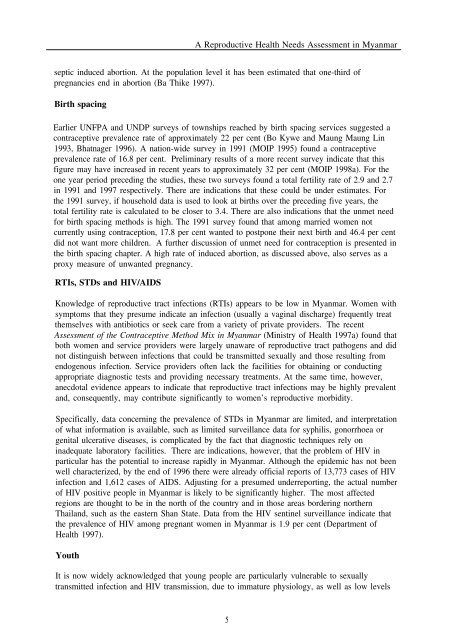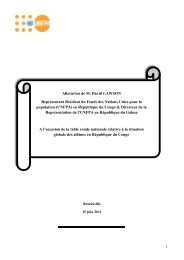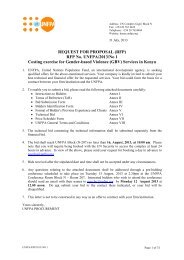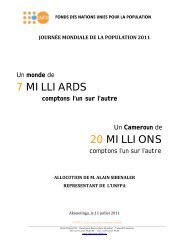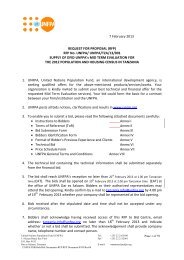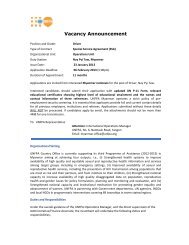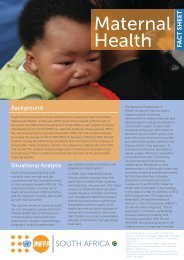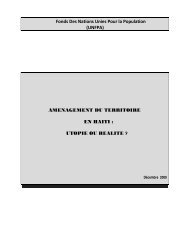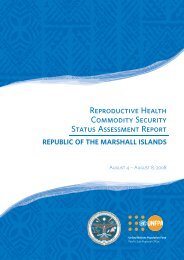A reproductive health needs assessment in Myanmar
A reproductive health needs assessment in Myanmar
A reproductive health needs assessment in Myanmar
You also want an ePaper? Increase the reach of your titles
YUMPU automatically turns print PDFs into web optimized ePapers that Google loves.
A Reproductive Health Needs Assessment <strong>in</strong> <strong>Myanmar</strong><br />
septic <strong>in</strong>duced abortion. At the population level it has been estimated that one-third of<br />
pregnancies end <strong>in</strong> abortion (Ba Thike 1997).<br />
Birth spac<strong>in</strong>g<br />
Earlier UNFPA and UNDP surveys of townships reached by birth spac<strong>in</strong>g services suggested a<br />
contraceptive prevalence rate of approximately 22 per cent (Bo Kywe and Maung Maung L<strong>in</strong><br />
1993, Bhatnager 1996). A nation-wide survey <strong>in</strong> 1991 (MOIP 1995) found a contraceptive<br />
prevalence rate of 16.8 per cent. Prelim<strong>in</strong>ary results of a more recent survey <strong>in</strong>dicate that this<br />
figure may have <strong>in</strong>creased <strong>in</strong> recent years to approximately 32 per cent (MOIP 1998a). For the<br />
one year period preced<strong>in</strong>g the studies, these two surveys found a total fertility rate of 2.9 and 2.7<br />
<strong>in</strong> 1991 and 1997 respectively. There are <strong>in</strong>dications that these could be under estimates. For<br />
the 1991 survey, if household data is used to look at births over the preced<strong>in</strong>g five years, the<br />
total fertility rate is calculated to be closer to 3.4. There are also <strong>in</strong>dications that the unmet need<br />
for birth spac<strong>in</strong>g methods is high. The 1991 survey found that among married women not<br />
currently us<strong>in</strong>g contraception, 17.8 per cent wanted to postpone their next birth and 46.4 per cent<br />
did not want more children. A further discussion of unmet need for contraception is presented <strong>in</strong><br />
the birth spac<strong>in</strong>g chapter. A high rate of <strong>in</strong>duced abortion, as discussed above, also serves as a<br />
proxy measure of unwanted pregnancy.<br />
RTIs, STDs and HIV/AIDS<br />
Knowledge of <strong>reproductive</strong> tract <strong>in</strong>fections (RTIs) appears to be low <strong>in</strong> <strong>Myanmar</strong>. Women with<br />
symptoms that they presume <strong>in</strong>dicate an <strong>in</strong>fection (usually a vag<strong>in</strong>al discharge) frequently treat<br />
themselves with antibiotics or seek care from a variety of private providers. The recent<br />
Assessment of the Contraceptive Method Mix <strong>in</strong> <strong>Myanmar</strong> (M<strong>in</strong>istry of Health 1997a) found that<br />
both women and service providers were largely unaware of <strong>reproductive</strong> tract pathogens and did<br />
not dist<strong>in</strong>guish between <strong>in</strong>fections that could be transmitted sexually and those result<strong>in</strong>g from<br />
endogenous <strong>in</strong>fection. Service providers often lack the facilities for obta<strong>in</strong><strong>in</strong>g or conduct<strong>in</strong>g<br />
appropriate diagnostic tests and provid<strong>in</strong>g necessary treatments. At the same time, however,<br />
anecdotal evidence appears to <strong>in</strong>dicate that <strong>reproductive</strong> tract <strong>in</strong>fections may be highly prevalent<br />
and, consequently, may contribute significantly to women’s <strong>reproductive</strong> morbidity.<br />
Specifically, data concern<strong>in</strong>g the prevalence of STDs <strong>in</strong> <strong>Myanmar</strong> are limited, and <strong>in</strong>terpretation<br />
of what <strong>in</strong>formation is available, such as limited surveillance data for syphilis, gonorrhoea or<br />
genital ulcerative diseases, is complicated by the fact that diagnostic techniques rely on<br />
<strong>in</strong>adequate laboratory facilities. There are <strong>in</strong>dications, however, that the problem of HIV <strong>in</strong><br />
particular has the potential to <strong>in</strong>crease rapidly <strong>in</strong> <strong>Myanmar</strong>. Although the epidemic has not been<br />
well characterized, by the end of 1996 there were already official reports of 13,773 cases of HIV<br />
<strong>in</strong>fection and 1,612 cases of AIDS. Adjust<strong>in</strong>g for a presumed underreport<strong>in</strong>g, the actual number<br />
of HIV positive people <strong>in</strong> <strong>Myanmar</strong> is likely to be significantly higher. The most affected<br />
regions are thought to be <strong>in</strong> the north of the country and <strong>in</strong> those areas border<strong>in</strong>g northern<br />
Thailand, such as the eastern Shan State. Data from the HIV sent<strong>in</strong>el surveillance <strong>in</strong>dicate that<br />
the prevalence of HIV among pregnant women <strong>in</strong> <strong>Myanmar</strong> is 1.9 per cent (Department of<br />
Health 1997).<br />
Youth<br />
It is now widely acknowledged that young people are particularly vulnerable to sexually<br />
transmitted <strong>in</strong>fection and HIV transmission, due to immature physiology, as well as low levels<br />
5


